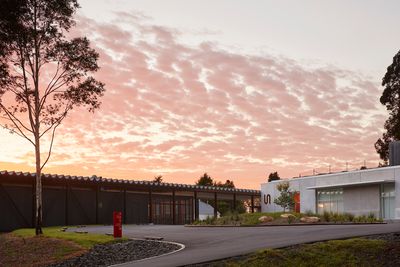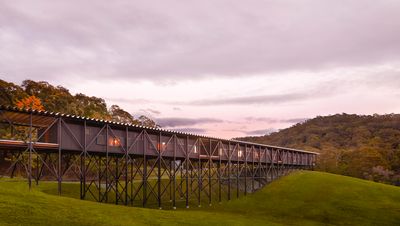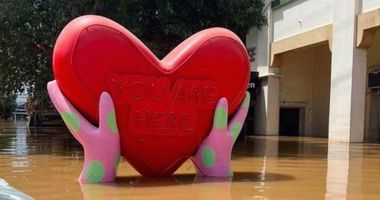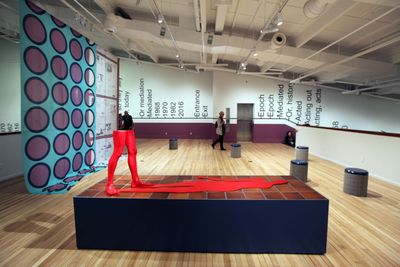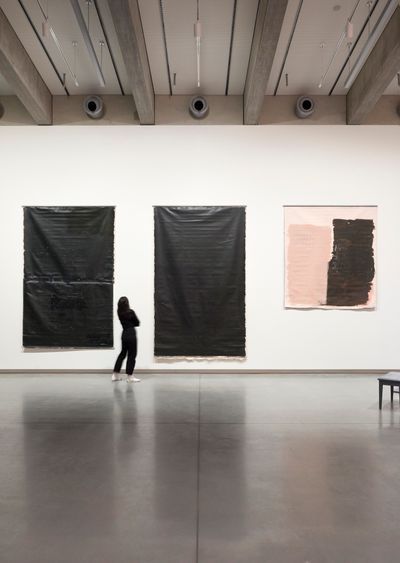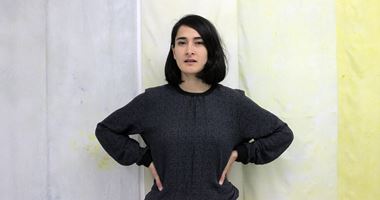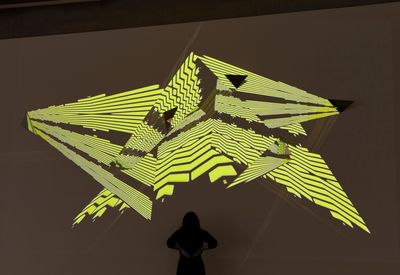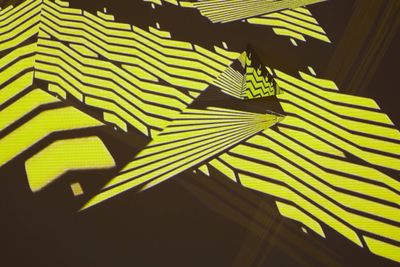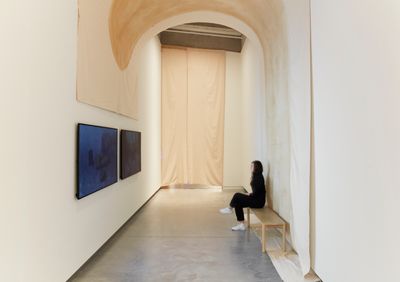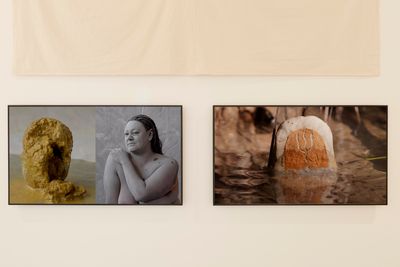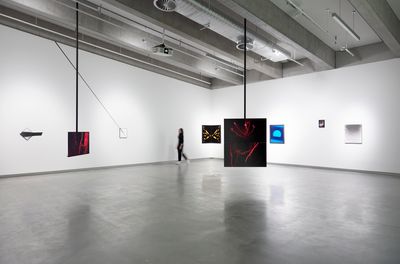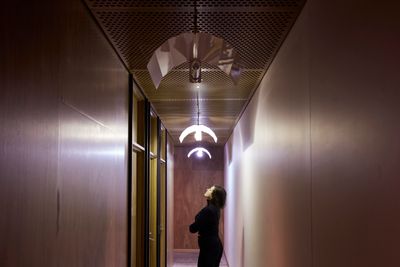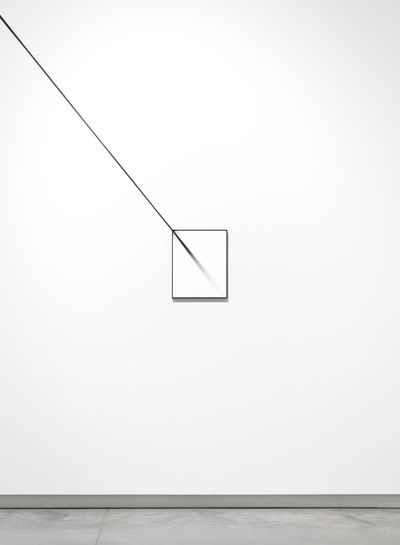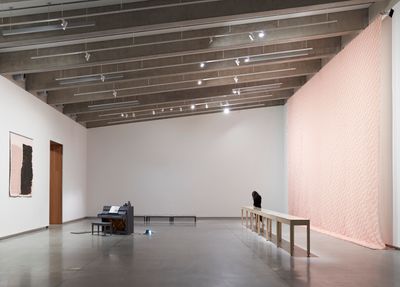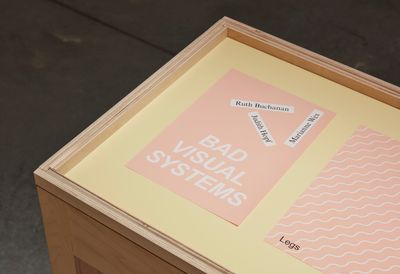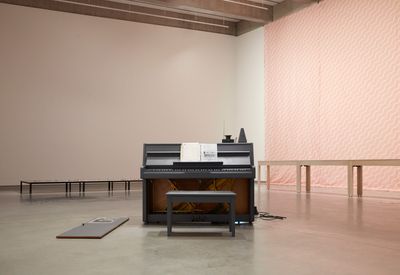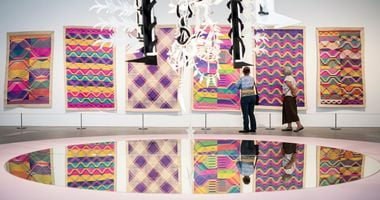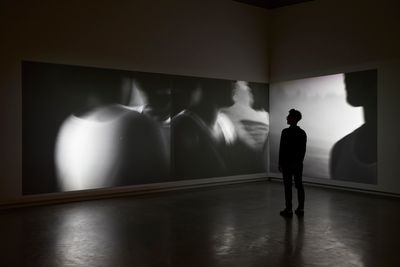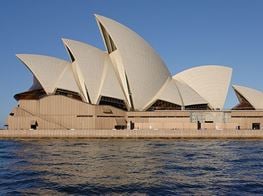In Oceanic Chorus, Come Hell or High Water
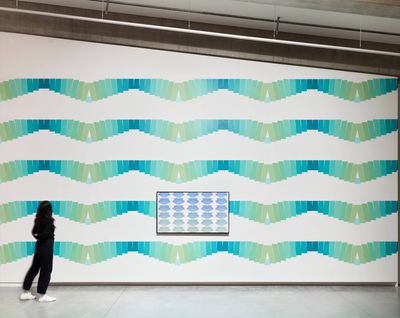
Sione Faletau, Fou ki moana / By way of the ocean (2023). Kupesi of audio recording of Shoalhaven River. 5 min. Exhibition view: The Polyphonic Sea, Bundanon, Illaroo (8 July–8 October 2023). Photo: Zan Wimberley.
In the deep valleys bordering the Shoalhaven River, on land belonging to the people of the Dharawal and Dhurga language groups, a new exhibition at Bundanon calls for a multisensory engagement with language.
Situated on a thousand hectares of land and native bush, Bundanon is an art museum, wildlife sanctuary, and residency complex in remote New South Wales, Australia, two-and-a-half hours south of Sydney. Through the Shoalhaven River, it is connected to the coast and the Tasman Sea. The property was gifted to the Australian people in 1993 by painter Arthur Boyd and his wife Yvonne, who resided at the estate's 19th-century homestead from the early 1980s.
Early in July, the gallery opened The Polyphonic Sea (8 July–8 October 2023), a multidisciplinary exhibition featuring 12 contemporary artists from Aotearoa New Zealand. It is their first show with artists outside of Australia since reopening in March last year following the Black Summer bushfires of 2019 to 2020. These came uncomfortably close to Bundanon's grounds, forcing the institution to rethink ways to future-proof their architectural design.
As a result, the museum—designed by Kerstin Thompson Architects—is partly embedded in a hillside with only the facade visible for fire and weather resilience and thermal stability. The adjacent 165-metre-long bridge, which houses accommodation and learning spaces, adheres to passive design principles and is elevated for flood protection.
The opening of Bundanon's new museum provided the chance to reconnect with international artists following the restrictions of Covid-19. But rather than traversing the globe, Bundanon's Head of Curatorial and Learning Sophie O'Brien looked across the Tasman Sea, latitudinally east, towards neighbouring Aotearoa New Zealand.
The Australian curator has a comprehensive career history both nationally (Artspace Sydney, Biennale of Sydney, Australian Pavilion at Venice) and internationally (Tate Britain, Serpentine Galleries). O'Brien also spent two years at the Govett-Brewster Art Gallery in New Zealand, where she worked with several artists in The Polyphonic Sea including Ruth Buchanan, Andrew Beck, and The Estate of L. Budd.
It is perhaps these existing relationships that provide a firm foundation on which to build a major show with New Zealand artists, and in turn revisit a lineage of exhibitions bridging the trans-Tasman divide. Such examples have included Headlands: Thinking Through New Zealand Art (1992) at the Museum of Contemporary Art Australia in Sydney and Close Quarters: Contemporary Art from Australia and New Zealand (1998), which toured venues in both countries.
'Through Covid, many people thought about how they might reconnect to near neighbours, rather than always turning to the U.K. or U.S. as "international". Thinking about the region of Oceania was key for me because of the very real geological connection—where a whole lot of islands were once connected,' O'Brien said.
'That's why events like the Asia Pacific Triennial are so important, and why the Sydney Biennale has such an important history here,' she said.
The Polyphonic Sea examines language in its myriad forms—whether visual, verbal, musical, gestural, or tacit. 'We all exist in this sea of languages,' O'Brien said. The word polyphony originates from the Greek poluphōnia, meaning many sounds, and more specifically a composition or sonic texture comprising two or more simultaneous but independent melodies.
Artists include Antonia Barnett-McIntosh, Andrew Beck, Ruth Buchanan, The Estate of L. Budd, Sione Faletau, Samuel Holloway et al., Sarah Hudson, Sonya Lacey, Nova Paul, Sriwhana Spong, and Shannon Te Ao. Of these artists, Barnett-McIntosh, Faletau, Hudson, and Lacey travelled to Bundanon for short-term residencies to produce new site-responsive commissions.
During her residency, Barnett-McIntosh made indoor and outdoor field recordings along with recordings of her narrated observations of the Shoalhaven riverbank. Together, they form the score of Unspoken (2023), a five-channel sound installation that emanates from five speakers at head height, each erected on slim poles and arranged in circular formation.
The darkened room heightens viewers' sensitivity to sounds of overlapping conversation, birdsong, and indiscernible intonations. It is a cacophony that derails preconceived sonic hierarchies, instead encouraging an open ear and mind.
For Sione Faletau, this exhibition is his first outside of Aotearoa. Presented on the gallery's entrance wall is Fou ki moana / By way of the ocean (2023), Faletau's large-scale digital installation that responds to the surrounding river. The artist visited Bundanon in June to develop the work, making ambient audio recordings at the Shoalhaven riverbank.
'Every time I go to a place, it's always the water that I'm drawn to,' he said. 'I put that down to my lineage—as descending from navigators in Tonga, from my father's whakapapa (ancestry or genealogy).'
Faletau used the frequencies extracted from his recordings at the river site as source material and translated them into kupesi (patterns or stencils). 'Kupesi are also a mark of time and space, marking contexts and histories,' Faletau said.
In Fou ki moana, these kupesi manifest as geometrical designs in a gradient of bright blues to greens, angled at eight degrees as a metaphor for infinity. The kupesi on the digital screen are amplified and enlarged on the surrounding wall, which provides a visual blueprint for sounds of the Shoalhaven.
Faletau's second work, Fonua / Embedded in the land (2023), emerges from a more personal sound recording—that of his daughter Vasilini's heartbeat in an ultrasound at six weeks old, which is projected onto an angular mirror installation. Fonua has many meanings in Tongan—land, people of the land, and the womb or placenta. 'All these forms of land encapsulate protections, shelter, nourishment for humans,' Faletau says.
Sharing an embodied perspective on the land is Sarah Hudson, whose installation The hill inside (2023) emerged from research and relationships developed during her residency in April. A pair of videos are presented side by side under a tall, arched sheet of canvas. Painted with earth pigments and topsoil from Bundanon's site, the fabric scales the opposing corridor wall from floor to ceiling, dropping above the screens.
O'Brien describes Hudson's presentation as 'a reconstruction of the hill on which we stand, painted with the earth of the hill itself.' In this way, Hudson's work becomes a geological transcription of the immediate landscape and a personal acknowledgement of place.
Language, communication, and translation are ideas that Auckland-based artist Sonya Lacey has explored for many years. In the weeks leading up to the exhibition, Lacey resided at Bundanon's historic workers' cottage to produce a video that posits the camera as a tool for translation.
Using a modified DSLR camera which she affectionately calls the 'Astromod', Lacey filmed the bush flora on the fringes of the garden surrounding the residence at night. Her removal of a filter in the camera lets ultraviolet and infrared light pass through, enabling the camera to detect things that the human eye cannot, in a process Lacey describes as 'blind note-taking'.
The resulting three-channel silent video installation, Chlorophyll (night vision) (2023), presents an endless loop of closeups of branches, foliage, and vines, with two of the monitors stacked vertically. The plants, seen through Lacey's modified lens, emit a phosphorescent red glow against a dark background and her camerawork appears almost as stop-motion, with staccato frames subtly jerking across the bush.
'I often think of multiple channels like a collage. It also problematises duration because these are very, very short. I like playing with timescales,' Lacey said.
'The video is a way to think about cohabitation, as a methodology to think about being "with" plants—a sort of collapsing of physiologies,' she said.
Complementing this is You look just like a human potted plant (GMT+12) (2023), Lacey's series of three grow lamps installed above the passageway to the gallery bathrooms. Each lamp emits light at a different wavelength and lights up according to local New Zealand time—invariably using anthropocentric timescales as a framework to disrupt the stability of time and place.
Inhabiting the walls surrounding Lacey's video is Andrew Beck's Impasse (2023), a series of silver gelatin prints on paper and glass. Some images appear to extend beyond their frames, with a pair of prints appearing to mirror one another, set perpendicular side by side in a corner.
For Beck, the concept of visual representation becomes an impasse—an amorphous, inward-facing language resulting from the many images that inundate viewers daily.
Sharing space in the museum's largest gallery are adapted re-presentations of existing works by Ruth Buchanan, The Estate of L. Budd, Samuel Holloway et al., Nova Paul, and Sriwhana Spong.
Buchanan presents three works including a new iteration of a spray-paint work, My I, I, I be broke (2019/2023), and a representation of a 2016 geo-mesh print and steel installation A wavy line is drawn across the middle of the original plans, where a 13-metre-wide peach-pink banner is hung slightly off the wall, patterned with wavy diagonal lines.
In front of the banner is a separate, long vitrine containing cut-up copies of the 2017 catalogue published for Buchanan's group exhibition, BAD VISUAL SYSTEMS: Ruth Buchanan, Judith Hopf, Marianne Wex (2016) at Te Pātaka Toi Adam Art Gallery, Wellington. The self-referential nature of Buchanan's presentation, where the exhibition history of each work is consciously cited in the exhibition's accompanying catalogue, questions the ongoing life, re-presentation, and translation of a practice.
On the show as a whole, Buchanan observed: 'Each of us, in our own way, are activating language in its full potential as a tool of the imagination, and where imagination is understood as working towards wholeness, bringing things together.'
'Language is never finished and is also something we can't own, but rather can metabolise, expand, interrupt, explore. I think the exhibition has managed to capture this fullness in a grounded way, crossing generations and contexts,' she said.
Nearby, Sriwhana Spong's snake-like bronze sculpture, Instrument H (Monster Chicken) (2021), is played as a musical instrument at daily intervals, while at a distance stands a 'real' instrument—a grey-painted upright piano, also poised to be played.
This is the work of Samuel Holloway et al. Pinned to the piano's rear, and resting on its music shelf, are piles of annotated sheet music—representing the scores of all pieces that have been performed on past iterations of Upright Piano Bundanon (2023), as well as the newest score, all of which are played intermittently in the room as a recording on a soundtrack.
As a sympathetic backdrop, the anonymous collective known as The Estate of L. Budd presents a series of modified roller blinds, painted in dark greys and pinks.
Nova Paul and Shannon Te Ao bring reformations of existing film and video works that speak to Indigenous language and communication through the natural environment.
Paul's work, Ngā Pūrākau Nō Ngā Rākau — Stories from the Trees (2023), combines three previous films in a new 31-minute sequence on two standing screens. Paul developed the 16mm film using a self-made plant-based developer incorporating the bark and leaves of the trees that are part of the work's subject.
Filmed against the backdrops of Aotea and Whangārei, where the artist has family and community ties, Paul combines these experimental technical approaches with images of tino rangatiratanga (Māori self-determination). O'Brien notes the work is 'very much about connection to country, community, story, culture, and the empowerment of Māori people'.
Shannon Te Ao presents la rā, ia rā (rere runga, rere raro) Everyday (I fly high, I fly low) (2021), a black-and-white, three-channel video installation that was originally commissioned for the 10th Asia Pacific Triennial of Contemporary Art.
Accompanying the lyrical motions of two young men (played by Zen Te Hira and Heremaia Tapiata Bright) against the landscape is a song written by Kurt Komene about the tīwakawaka (fantail), a native New Zealand bird of symbolic significance in Māori culture—commonly understood as an indicator of death or mortality.
On la rā, ia rā, Te Ao described his intent 'to interrogate how we tell stories and how we perceive narrative'. O'Brien adds her understanding of the tīwakawaka in Te Ao's story as a potential messenger 'between the physical and intangible worlds—not so much a spirit world, but a world of messages that come from the natural environment'.
The Polyphonic Sea offers a rich and poetic sensory experience, with O'Brien bringing together a multiplicity of languages held sensitively together by the chorus of 12 artists.
Where the exhibition shines is through the artists who have resided on-site, responding to Bundanon's location through new works. They ground the show with a localised sensibility, regenerating a continuum of Aotearoa-Australia artistic relationships, and enabling new connections to form and develop, both to people and place. —[O]

